My interest in railways started when I attended Surbiton Grammar School at the age of 11. The school was located just a few yards from the cutting leading to Surbiton Station on the Southern Region mainline. After a few years of just number taking, I started railway photography, firstly using black and white film and then progressing to colour slides late in 1963.
By the first half of the 1960s, things were disappearing fast. One such was the Somerset and Dorset line. The Somerset and Dorset Joint Railway (SDJR) was formed in 1862 by the amalgamation of the Somerset Central and Dorset Central Railways. For some reason, I had paid little attention to this line, and my only concerted effort was close to the time of its closure.
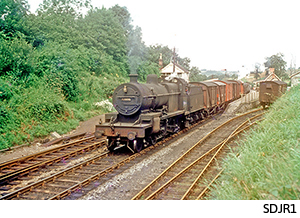 The SDJR main line ran in a roughly north-south direction between Bath and Bournemouth. Being operated jointly by the Midland and Southern Regions and their predecessors, but running right through Western Region territory, it was always a thorn in the side of the Western authorities. When operation of the line was transferred to the Western region in 1958, the writing was on the wall, and the line was rapidly run down. Its life-blood for many years had been the through trains from the midlands to the south coast, particularly the many summer Saturday holiday specials. The most important of these was the daily ‘Pines Express’ from Manchester to Bournemouth, and when this was transferred to run via Oxford and Basingstoke, this was definitely the beginning of the end.
The SDJR main line ran in a roughly north-south direction between Bath and Bournemouth. Being operated jointly by the Midland and Southern Regions and their predecessors, but running right through Western Region territory, it was always a thorn in the side of the Western authorities. When operation of the line was transferred to the Western region in 1958, the writing was on the wall, and the line was rapidly run down. Its life-blood for many years had been the through trains from the midlands to the south coast, particularly the many summer Saturday holiday specials. The most important of these was the daily ‘Pines Express’ from Manchester to Bournemouth, and when this was transferred to run via Oxford and Basingstoke, this was definitely the beginning of the end.
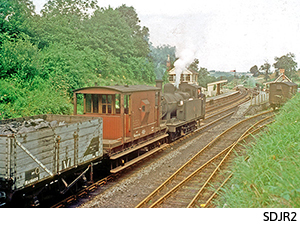 The closure of the line was announced and finally confirmed in 1965. Even so, the SDJR being such a strategic north – south route, no-one really believed that the vindictiveness of the Western Region authorities would be upheld by Barbara Castle (then Minister of Transport), but it was! Closure was scheduled for 3rd January 1966, but due to problems with providing alternative bus services, it was postponed until 6th March 1966. The line was steam worked right to the end.
The closure of the line was announced and finally confirmed in 1965. Even so, the SDJR being such a strategic north – south route, no-one really believed that the vindictiveness of the Western Region authorities would be upheld by Barbara Castle (then Minister of Transport), but it was! Closure was scheduled for 3rd January 1966, but due to problems with providing alternative bus services, it was postponed until 6th March 1966. The line was steam worked right to the end.
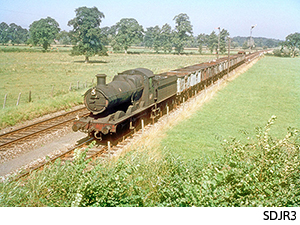 My first visit to the line to photograph regular workings was in August 1964 when I was returning home from a photographic trip to the West Country. On SDJR1, we see ex-SDJR Class 7F 2-8-0 53806 climbing past Midsomer Norton with the 2.00pm freight ex-Bath. Since the amalgamation, motive power was the primary responsibilty of the Midland Railway and its successors, and these locos were specially designed for the line by Fowler in 1914, eventually totalling 11.
My first visit to the line to photograph regular workings was in August 1964 when I was returning home from a photographic trip to the West Country. On SDJR1, we see ex-SDJR Class 7F 2-8-0 53806 climbing past Midsomer Norton with the 2.00pm freight ex-Bath. Since the amalgamation, motive power was the primary responsibilty of the Midland Railway and its successors, and these locos were specially designed for the line by Fowler in 1914, eventually totalling 11.
The line between Bath and Evercreech Junction crossed the Mendips, with gradients as steep as 1 in 50. As a consequence, freights such as this need assistance, and here we see ex-LMS ‘Jinty’ 0-6-0T providing banking assistance (SDJR2).
By this time, the Great Western influence was beginning to be felt, and an ex-GWR 0-6-0 2217 is seen approaching Templecombe with a freight (SDJR3) on the same day in August 1964.
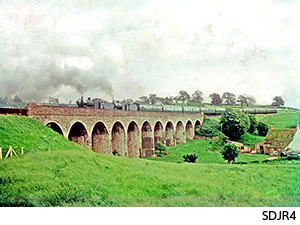 I had made a visit a couple of months earlier, on 7th June 1964, specially to photograph a Home Counties Railway Society trip over the line via Bournemouth from Waterloo. The attraction was that it involved the use of two former SDJR locos, 7F 53807 plus ex-LMS 4F 0-6-0 44558. This was one of five locos of this Class of 580 built specifically for use on the SDJR, which remained on the line until withdrawl. SDJR4 sees the pair crossing Prestleigh Viaduct, near Shepton Mallet, on the northbound climb to the summit at Masbury.
I had made a visit a couple of months earlier, on 7th June 1964, specially to photograph a Home Counties Railway Society trip over the line via Bournemouth from Waterloo. The attraction was that it involved the use of two former SDJR locos, 7F 53807 plus ex-LMS 4F 0-6-0 44558. This was one of five locos of this Class of 580 built specifically for use on the SDJR, which remained on the line until withdrawl. SDJR4 sees the pair crossing Prestleigh Viaduct, near Shepton Mallet, on the northbound climb to the summit at Masbury.
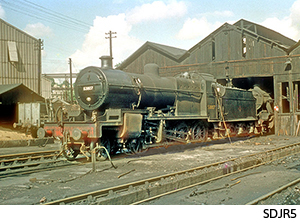 A sight such as this would have been commonplace on freights, and even through passenger trains on a summer Saturday. SDJR5 and 6 show the locos at rest on the shed at Bath Green Park after their part of the tour. The trip continued over the Midland route to Gloucester via Mangotsfield, with the rather inconguous power for the line of Ex-GWR Castle Class 4-6-0 7023 ‘Penrice Castle’, seen on SDJR7 near Bitton, on what is now part of the Avon Valley Railway.
A sight such as this would have been commonplace on freights, and even through passenger trains on a summer Saturday. SDJR5 and 6 show the locos at rest on the shed at Bath Green Park after their part of the tour. The trip continued over the Midland route to Gloucester via Mangotsfield, with the rather inconguous power for the line of Ex-GWR Castle Class 4-6-0 7023 ‘Penrice Castle’, seen on SDJR7 near Bitton, on what is now part of the Avon Valley Railway.
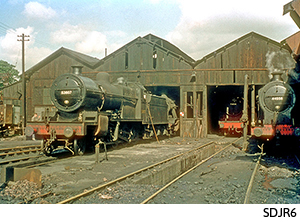 My next visit to the line was not until the original closure date of 2nd January 1966, when a special train, again originating from Waterloo via Bournemouth, was worked over the line, this time with Southern motive power, ‘U’ Class 2-6-0 31639 plus ‘WC’ Class 4-6-2 34015 ‘Exmouth’, seen near Wincanton (SDJR8) and again Prestleigh Viaduct (SDJR9). Southern motive power was not uncommon over the line, and indeed for a period in the early 1950s, three West Country Class pacifics were allocated to Bath Green Park. During this visit, I photographed ex-BR Class ‘5MT’ 73001 leaving Cole on a morning train for Templecombe (SDJR10).
My next visit to the line was not until the original closure date of 2nd January 1966, when a special train, again originating from Waterloo via Bournemouth, was worked over the line, this time with Southern motive power, ‘U’ Class 2-6-0 31639 plus ‘WC’ Class 4-6-2 34015 ‘Exmouth’, seen near Wincanton (SDJR8) and again Prestleigh Viaduct (SDJR9). Southern motive power was not uncommon over the line, and indeed for a period in the early 1950s, three West Country Class pacifics were allocated to Bath Green Park. During this visit, I photographed ex-BR Class ‘5MT’ 73001 leaving Cole on a morning train for Templecombe (SDJR10).
My final visit was for the few days leading to the ultimate closure. Travelling down by car on Thursday 3rd March with Graham Hoare, we photographed a number of service train, which had become rather scarce since the start of the ’emergency’ service introduced on 3rd January to tide things over until the complete closure. We were then joined on Friday evening by four other colleagues, completely filling the B&B we had found near Shepton Mallet (Bill Sumner having to sleep on the floor!).
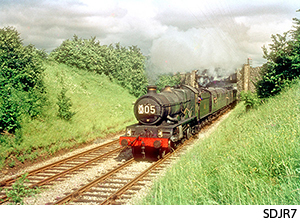
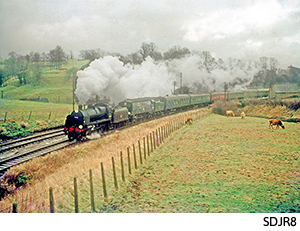
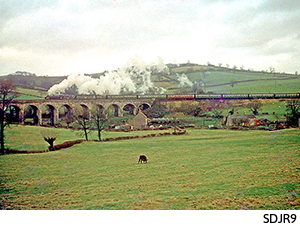
SDJR11 – a train with a BR 4MT 2-6-4T from Templecombe leaving Shepton Mallet for Bath, early in the morning (before breakfast!) on the last day of scheduled passenger working, Saturday 5th March 1966.
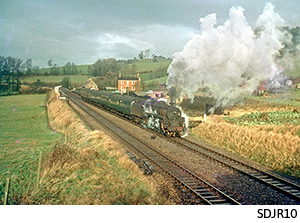
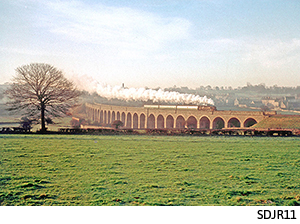
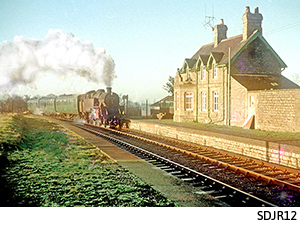
SDJR12 – the same train the day before breasting the summit at Masbury Halt with BR Class 4MT 2-6-4T 80034.
SDJR13 – BR 4MT 2-6-4T 80043 is climbing towards Chilcompton with a late afternoon train from Bath on Friday 4th March.
SDJR14 – former LMS motive power was still to be seen on 5th March, with 8F 2-8-0 48767 leaving Binegar on morning train from Bath to Templecombe.
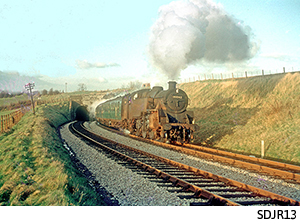
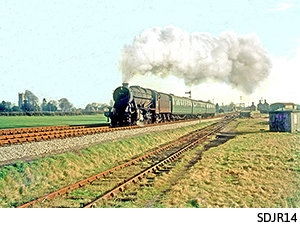
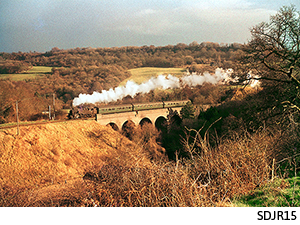
SDJR15 – a BR 4MT 2-6-4T is crossing the viaduct at Monkton Combe as it approaches Combe Down Tunnel with an afternoon train for Bath. Although the line from Templecombe was double track for most of the route to Bath, it singled at Midford for the last 4 miles into Bath. The narrow bore Devonshire and Combe Down tunnels on this section were infamous for the choking conditions caused by hard working steam locomotives.
SDJR16 – this unusual working (double-heading hardly necessary for a 2 coach train) took place on Saturday 5th March, with the object of transferring any remaining locomotives from Templecombe depot to Bath Green Park shed prior to disposal.
At the time of this visit, Writhlington Colliery, about a mile east of Radstock, was still active, and served by ‘Jinty’ 0-6-0Ts based at Radstock shed. On the morning of Friday 4th March, 47276 is running from Radstock to shunt at the Colliery (SDJR17).
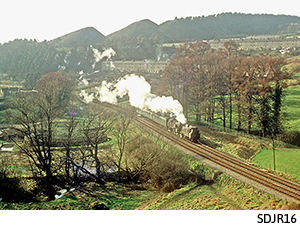
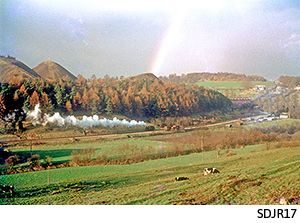
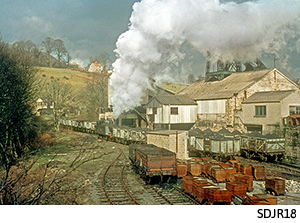
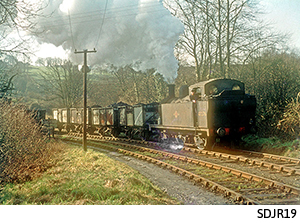
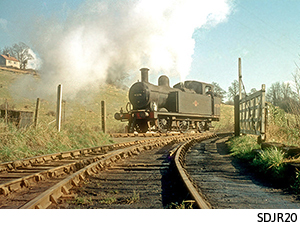
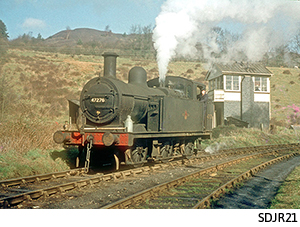
It took some effort on behalf of 47276 to lift loaded coal wagons up from the colliery itself to the exchange sidings on the main line (SDJR18 & 19). SDJR20 shows 47276 at the top of the Colliery spur, the incline being well evident, as it is in SDJR21 with the junction signal box in the background. SDJR22 shows 47276 shunting at the exchange sidings. Later in the day 47276 worked a freight to Bath, seen between Radstock and Writhlington (SDJR23).
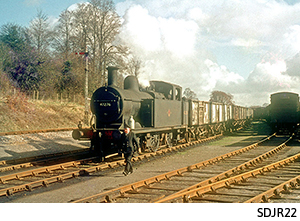
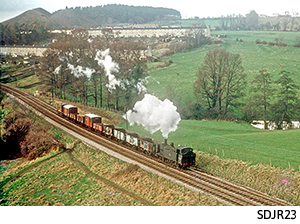
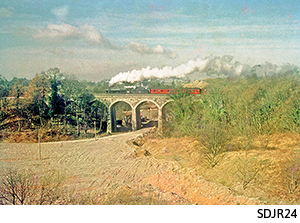
On the Saturday, two special train were worked over the line. Ex_LMS 8F 2-8-0 48706 worked a Great Western Society special from Bath to Bournemouth and return. SDJR24 shows this train on its outward journey near Binegar, and then SDJR25 with a view overlooking Pitcombe Church, near Cole. The return trip is viewed travelling downhill near Gurney Slade (SDJR26).
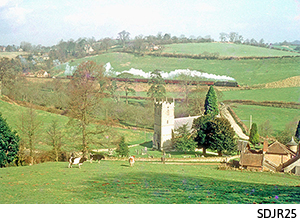
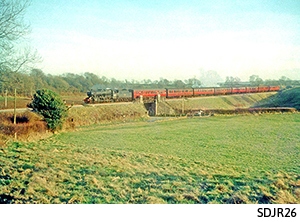
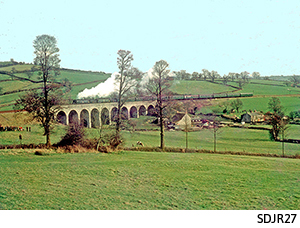
The other train was run by the LCGB, starting from Waterloo, but proceeding down the mainline to Templecombe. It ran from there on SDJR metals on the branch to Highbridge, and then back to Evercreech Junction, where ex-SR 4-6-2s 34006 ‘Bude’ and 34057 ‘Biggin Hill’ took the train to Bath and back to Bournemouth. SDJR27, 28 & 29 show this train climbing towards Shepton Mallet at Prestleigh Viaduct. SDJR29 in particular shows the lengthened smoke deflectors attached to 34006, which it uniquely carried for as long as I can remember. On SDJR30, they are shown coasting downhill towards Chilcompton – WW2 tank traps are still in the fields. They are climbing towards Binegar passing a flooded quarry working on the return trip (SDJR31).
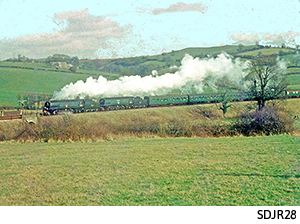
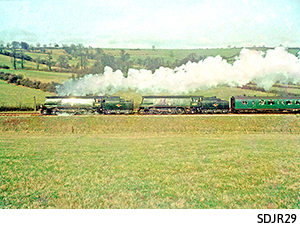
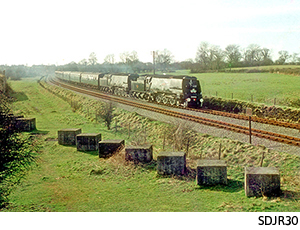
The final day, Sunday 6th March 1966 typically dawned cloudy, and the weather deteriorated further during the day. There were no scheduled services, but again two special trains ran over the line. The Stephenson Locomotive Society ran a trip from Bath to Bournemouth and return. 8F 2-8-0 48706 plus 5MT 2-6-4T 80043 are climbing towards Binegar (SDJR32), seen leaving Shepton Mallet (SDJR33), and approaching Wincanton (SDJR34).
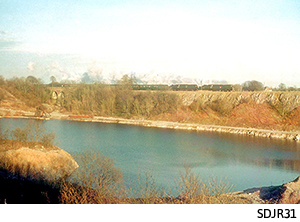
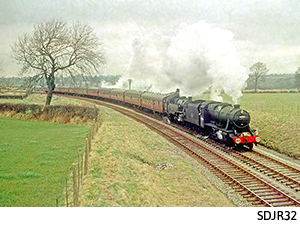
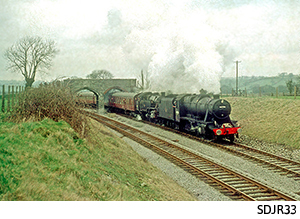
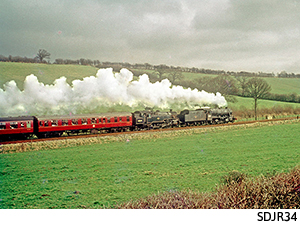 The significance of Templecombe is worthy of note. It was here than the SDJR passed under the SR mainline from Salisbury to Exeter. Although a small platform existed on the single line southwards, most trains travelled up a spur to the platforms on the SR line. This necessitated a reversal for trains travelling in either direction requiring a pilot locomotive. There was a loco shed on the SDJR to provide this, and various trip workings to Highbridge and Bath.
The significance of Templecombe is worthy of note. It was here than the SDJR passed under the SR mainline from Salisbury to Exeter. Although a small platform existed on the single line southwards, most trains travelled up a spur to the platforms on the SR line. This necessitated a reversal for trains travelling in either direction requiring a pilot locomotive. There was a loco shed on the SDJR to provide this, and various trip workings to Highbridge and Bath.
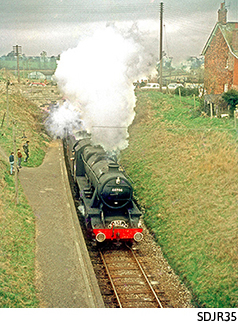 SDJR35 shows the SLS special passing the small SDJR platform at Templecombe Lower, which was situated between a minor road overbridge and the SR mainline, from which this image was taken.
SDJR35 shows the SLS special passing the small SDJR platform at Templecombe Lower, which was situated between a minor road overbridge and the SR mainline, from which this image was taken.
This train passed the RCTS ‘Farewell Tour’ at Blandford Forum, which was hauled from Waterloo via Bournemouth to Templecombe by ex-SR ‘MN’ Class 4-6-2 35028 ‘Clan Line’, and is seen here from the SR mainline approaching and passing through Templecombe Lower platform (SDJR36 & 37). I hasten to point out that I was standing adjacent to the main line with permission, having a lineside pass. The weather having deteriorated, and with work beckoning the following day, we returned home at this point.
From 7th March 1966, the line closed completely, apart from 3 small sections. Blandford Forum remained open for freight only until 1969, being accessed from the Bournemouth end. A section of the Highbridge Branch remained open from the GWR mainline to the United Dairies creamery at Bason Bridge until 1972. Since 3 collieries near Radstock, including Writhlington Colliery, were still in use, a connection was made just south of Radstock with the GWR line to Frome. There was no delay in doing this, since the work was carried out on the morning of 6th March, as seen here on SDJR38. Due to this, both the southbound specials were required to run on the northbound line. After the last coal was extracted from the Somerset Coalfielld at the end of September 1973, this spur was dismantled.
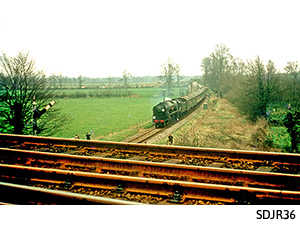
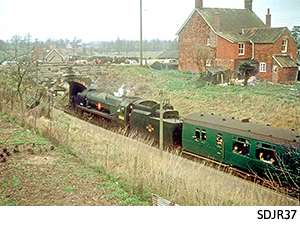
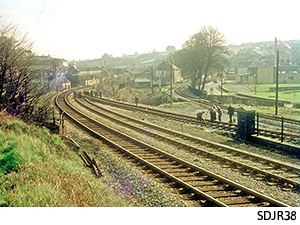
Laurie Golden